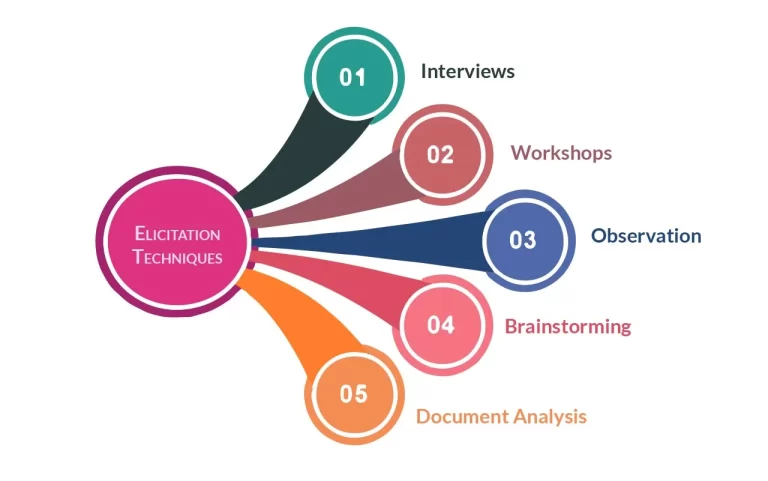Proven Practices to conduct Requirements Elicitation Services
Our Approach
Led by our senior consultant, our requirement discovery sessions are designed to facilitate effective communication and collaboration among subject matter experts. Using a unique and proven approach, our consultants employ practical questioning and analysis techniques to keep participants focused and on track. Unlike contract business analysts, StatsWork consultants follow a consistent and standardized approach certified by StatsWork, ensuring high-quality and reliable results.Our consultants take full responsibility for the documentation and production of deliverables, capturing all necessary models, diagrams, and narratives. The end result is a high-quality standardized deliverable that can be seamlessly handed over to your internal business analyst or business system analyst. Through our collaborative sessions, we prioritize overcoming obstacles and achieving commitment, consensus, and agreement, leading to immediate and successful outcomes.With our expertise and dedication to proven practices, StatsWork is your trusted partner for conducting requirements elicitation services that lay the foundation for the success of your projects.

Transform your business with Requirement Elicitation Services with a typical engagement of 1-4 weeks on average



STAGE 1.
Project/Product Scoping
During the initial stage of the project or product scoping process, our main focus is to determine the specific requirements of your business. We engage in collaborative sessions with key stakeholders to gain a comprehensive understanding of your needs. We recognize that an application can serve multiple functionalities, and each function can have numerous use cases. Therefore, we assist you in defining these use cases before delving into the detailed business requirements. Our team of experienced developers and subject matter experts works closely with you to identify the high-level business process flow. We break down the flow into input, output, and sub-processes, ensuring a clear understanding of the order, interactions, and decision flows between them. This meticulous analysis lays the foundation for a well-defined project scope and sets the stage for successful implementation. At StatsWork, we value effective communication and collaboration throughout this scoping stage, enabling us to align our efforts with your business objectives. By partnering with us, you can ensure that your project or product begins on the right track, with a solid understanding of the use cases and a well-defined business process flow.

 STAGE 2.
STAGE 2.
Requirement Discovery Session.
During the requirement discovery session, we dive deep into understanding your business needs and objectives. Our expert team works closely with you to document requirements through meticulous annotation and categorization, ensuring accurate and comprehensive capturing of metadata. By implementing components of a pipeline and designing a system architecture that aligns with your outlined requirements, we create a solid foundation for the development process. At StatsWork, we go beyond just capturing requirements. We also assist in defining the optimal team structure and identifying the necessary resources to be staffed for your project. Our aim is to ensure that you have the right skill sets and expertise on board to successfully execute your initiatives. Additionally, we establish a framework for daily operations, streamlining processes and promoting efficiency throughout the project lifecycle. With our robust requirement discovery session, we enable you to have a clear understanding of your project’s scope and establish a roadmap for success. By combining our expertise in system architecture and conceptual design, along with our ability to define team structures and operational frameworks, we set the stage for the smooth execution of your requirements.

 STAGE 3.
STAGE 3.
Review, Analyses and Documentation
In the review and analysis stage, we thoroughly examine and document the requirements identified in the previous stages. This includes conducting a comprehensive analysis of the requirements, taking into consideration factors such as business rules, certifications, regulations, and market constraints. By incorporating these requirements, we ensure that your software solution complies with industry standards and meets all necessary criteria. During this stage, we also define the methodologies to be used in building the software, including selecting the appropriate programming language, software platform constraints, and hardware design constraints. Our experienced team follows best practices and leverages industry standards to ensure that your software is developed using the most effective and efficient approaches. At StatsWork, we understand the importance of thorough review, analysis, and documentation in the software development process. By carefully considering all aspects of your project, we lay the groundwork for a successful and high-quality software solution.

 STAGE 4.
STAGE 4.
Review and Validation
Our team of experts works on building machine learning (ML) models tailored to your specific use cases and business objectives. We leverage advanced algorithms and techniques to develop models that can analyze and interpret complex data patterns. Once the ML models are developed, we proceed with the deployment phase. This involves integrating the models into your existing systems or creating new infrastructure to host and run the models effectively. To enhance the performance and accuracy of the models, we augment the existing data used in the training process. This includes collecting additional relevant data, cleaning and preprocessing it, and incorporating it into the model’s training dataset. Our team helps you identify and select the most suitable ML models for your specific use cases. We consider factors such as the nature of your data, the complexity of the problem you want to solve, and the desired outcomes to determine the optimal model architecture and algorithms. We conduct rigorous evaluation and testing of the developed models to assess their performance and ensure they meet the desired criteria. This includes evaluating metrics such as accuracy, precision, recall, and F1 score to validate the effectiveness of the models. We fine-tune and optimize the ML models to improve their performance and efficiency. This may involve adjusting hyperparameters, optimizing feature selection, or implementing advanced techniques such as ensemble learning to enhance the model’s predictive capabilities.

